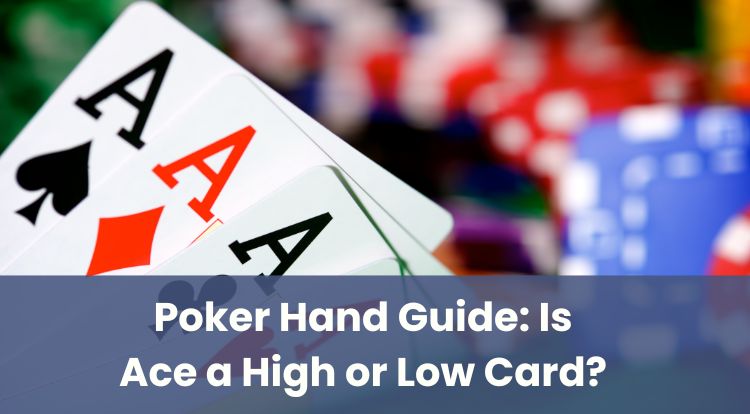
Understanding the role of the ace in poker may be a little confusing at first. In some situations, it is the highest-ranking card, while in others, it can take the lowest position. Both interpretations are correct, depending on the hand being played and the particular variation of poker.
This blog post explains when an ace acts as a high card, when it counts as low, how it behaves in specific combinations, and what happens if multiple players hold an ace.
Read on to gain a clearer understanding of the ace and its place in the game.
What Does the Ace Represent in Poker?
In poker, the ace stands apart from every other rank. It can rise above the king or fall below the two, switching its place depending on the type of hand being made and the rules of the format.
Most of the time, especially in popular games, the ace sits at the top. But there are certain patterns where it moves down to finish a sequence in a different way.
Because it’s the only rank that can move both ways, it’s useful to know how it’s being treated in the version you’re playing.
When Is an Ace High in Poker?
In well-known formats such as Texas Hold’em or Omaha, the ace usually takes the highest position. That means:
- A pair of aces stands above any other pair.
- A straight that finishes with an ace (ten to ace) is the strongest sequence.
- An ace-high hand ranks above one that peaks with a king when no pairs or stronger combinations appear.
If you choose to play, you may also notice the ace deciding close outcomes. If two players share the same main hand, the one whose spare card, known as a kicker, includes an ace will win. Later, we’ll look at moments where the ace moves to the bottom instead.
When Is an Ace Low in Poker?
There are times when the ace takes a different role. One familiar example is the lowest straight, often called the wheel, which reads A-2-3-4-5. In this case, the ace drops beneath the two to complete the run.
In a few poker variants that focus on low hands, the ace is also counted as the smallest rank when deciding the low side. In most common high-hand formats, it only drops for that A-2-3-4-5 straight.
This distinction matters once particular hand types come into play.
How Does Ace Work in Different Poker Hands?
Ace in a Straight
Within a straight, the ace may sit at either end of the sequence:
- Lowest straight: A-2-3-4-5, where the ace sits low.
- Highest straight: 10-J-Q-K-A, where the ace sits high.
The run must remain continuous. Only one ace can appear in a valid straight, and it cannot change position within the same five-card hand.
Ace in a Flush or Full House
In a flush, five cards of one suit, the ace ranks as the highest within that suit, placing an ace-high flush above any king-high one. If two players share a flush of the same suit, the result is settled by comparing each card in order from the top down. If all five cards match, the result is even.
In a full house, which joins three of a kind with a pair, the strength of the three matching cards decides who wins. For example, three aces with any pair rank above three kings with a pair of aces. If both show the same triplet, the pair decides it.
Can You Use an Ace as Both High and Low in the Same Hand?
Inside a single five-card hand, the ace must choose one place. It may begin a straight or end it, but it can’t occupy both ends at once, and it never connects a king to a two.
However, in versions of poker that divide pots between high and low sides, the evaluations are separate. In that case, an ace can appear high in one and low in the other—but each hand still treats it in only one position.
What Happens if Two Players Have an Ace?
When more than one player shows an ace, the surrounding cards make the difference. Poker hands follow fixed rankings, and if both players seem close, the next strongest cards, the kickers, decide who wins.
If both hold a pair of aces, the higher side card wins, such as A-A-K-9-3 beating A-A-Q-9-3. If those match, the cards are compared until one side takes it or the hands prove identical.
With ace-high combinations, an A-K-9-6-4 would top an A-Q-9-6-4 if the shared cards on the table give no player a pair.
Sometimes, the shared layout of community cards results in a draw, such as a straight that lies entirely on the board or a flush where both hands match through all five ranks. In that case, the winnings are divided evenly.
By recognising how the ace moves between positions and how ties unfold, you’ll have a clearer understanding of its role. If you choose to play, do so within your limits and keep each session balanced and mindful.
Poker should be enjoyed as a form of entertainment. Set clear time and spend limits, take regular breaks, and step away if it ever stops feeling enjoyable. If you’d like further support or advice, organisations such as BeGambleAware and GamCare offer free, confidential help and guidance.
Always play responsibly and keep your experience positive and informed.
**The information provided in this blog is intended for educational purposes and should not be construed as betting advice or a guarantee of success. Always gamble responsibly.
